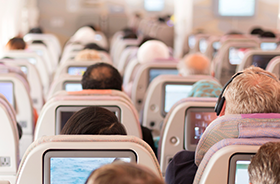

IATA: Global passenger traffic results for May shows that demand rose 4.6% compared to same month in 2015
Geneva, Switzerland, 2016-Jul-13 — /Travel PR News/ — The International Air Transport Association (IATA) announced global passenger traffic results for May showing that demand (measured in revenue passenger kilometers, or RPKs) rose 4.6%, compared to the same month in 2015, which was the same level achieved in April. Capacity climbed 5.5%, which pushed the average load factor down 0.7 percentage points to 78.7%. Demand for domestic traffic rose 5.1%, outpacing international demand growth of 4.3%.
“After a very strong start to the year, demand growth is slipping back toward more historic levels. A combination of factors are likely behind this more moderated pace of demand growth. These include continuing terrorist activity and the fragile state of the global economy. Neither bode well for travel demand. And the shocks of Istanbul and the economic fallout of the Brexit vote make it difficult to see an early uptick,” said Tony Tyler, IATA’s Director General and CEO.
| MAY 2016 (% YEAR-ON-YEAR) | WORLD SHARE1 | RPK | ASK | PLF (%-PT)2 | PLF (LEVEL)3 |
|---|---|---|---|---|---|
| Total Market | 100.0% | 4.6% | 5.5% | -0.7% | 78.7% |
| Africa | 2.2% | 8.6% | 9.4% | -0.5% | 65.7% |
| Asia Pacific | 31.5% | 6.6% | 6.9% | -0.2% | 76.9% |
| Europe | 26.7% | 2.0% | 2.8% | -0.6% | 80.2% |
| Latin America | 5.4% | 1.7% | 1.3% | 0.3% | 79.4% |
| Middle East | 9.4% | 11.2% | 15.4% | -2.7% | 72.1% |
| North America | 24.7% | 3.0% | 3.4% | -0.3% | 83.8% |
International Passenger Markets
Annual growth in international RPKs slowed for the third consecutive month, to 4.3%, from 5% recorded in April year-over-year. Airlines in all regions recorded growth. Total capacity climbed 6.1%, causing load factor to slip 1.3 percentage points to 77.1%
Domestic Passenger Markets
Domestic demand rose 5.1% in May compared to May 2015, which was up from the 4% year-on-year growth recorded in April. Results were decidedly mixed, with Brazil, Russia and Japan all showing declines. Domestic capacity climbed 4.4%, and load factor rose 0.5 percentage points to 81.7%.
| MAY 2016 (% YEAR-ON-YEAR) | WORLD SHARE1 | RPK | ASK | PLF (%-PT)2 | PLF (LEVEL)3 |
|---|---|---|---|---|---|
| Domestic | 36.4% | 5.1% | 4.4% | 0.5% | 81.7% |
| Australia | 1.1% | 0.4% | -2.9% | 2.5% | 75.0% |
| Brazil | 1.4% | -7.7% | -8.1% | 0.4% | 78.5% |
| China P.R. | 8.4% | 9.8% | 9.8% | 0.0% | 80.3% |
| India | 1.2% | 21.0% | 21.9% | -0.7% | 86.7% |
| Japan | 1.2% | -4.2% | -3.5% | -0.5% | 65.4% |
| Russian Federation | 1.3% | -3.5% | -8.0% | 3.5% | 74.8% |
| US | 15.4% | 4.4% | 4.3% | 0.1% | 85.9% |
The Bottom line
“The shockwaves of the Brexit vote have extended worldwide and the fallout will affect the air transport industry, from both economic and regulatory perspectives. Aviation plays a vital role in supporting economic growth and development. As the post-Brexit regulatory framework is negotiated between the EU and the UK it is critical that there are no steps backward for aviation connectivity,” said Tyler.
View May air passenger results (pdf)
For more information, please contact:
Corporate Communications
Tel: +41 22 770 2967
Email: corpcomms@iata.org
Notes for Editors:
It is less important for Europe and most of Africa where domestic travel represents just 11% and 14% of operations, respectively. And it is negligible for Middle Eastern carriers for whom domestic travel represents just 4% of operations
###
IATA: Global passenger traffic results for May shows that demand rose 4.6% compared to same month in 2015
(IN SHORT) flydubai will resume direct flights between Dubai and Pisa starting 1 April 2025,… Read More
(IN SHORT) Emirates has launched the Aircrafted Kids initiative to support children’s education across Asia… Read More
(IN SHORT) Emirates is set to reinstate its second daily flight between Dubai and Beirut… Read More
(IN SHORT) Minor Hotels is set to launch the NH Collection Asunción in Paraguay, a… Read More
(IN SHORT) Hotel Bellevue Cortina d’Ampezzo, Emblems Collection is set to become Italy’s first property… Read More
(IN SHORT) UN Tourism’s leadership recently wrapped up a significant visit to China, during which… Read More
This website uses cookies.